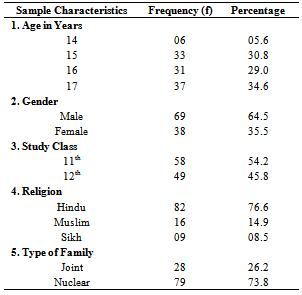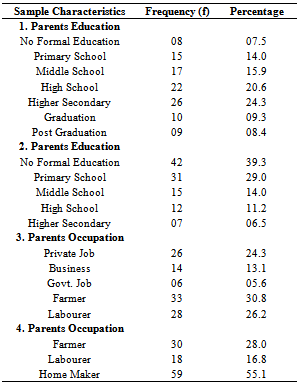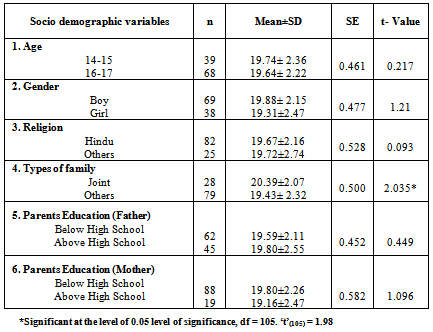-
Paper Information
- Paper Submission
-
Journal Information
- About This Journal
- Editorial Board
- Current Issue
- Archive
- Author Guidelines
- Contact Us
International Journal of Nursing Science
p-ISSN: 2167-7441 e-ISSN: 2167-745X
2013; 3(3): 57-61
doi:10.5923/j.nursing.20130303.01
Effectiveness of an Awareness Program about the Harmful Effects of Tobacco and Alcohol on Knowledge and Self Reported Practice of Adolescent Students Studying in a Selected School of Dehradun India
Brijesh Kumar, Ratna Prakash, Kamli Prakash, Muthuvenkatacha1lam S.
Department of Nursing, Himalayan College of Nursing, HIHT University, Dehradun, 248140, India
Correspondence to: Brijesh Kumar, Department of Nursing, Himalayan College of Nursing, HIHT University, Dehradun, 248140, India.
| Email: |  |
Copyright © 2012 Scientific & Academic Publishing. All Rights Reserved.
The aim of the study was to assess the effectiveness of an awareness program about the harmful effects of tobacco and alcohol on knowledge and self reported practice of adolescent students, so as to initiate a preventive action endeavor against the menace of tobacco and alcohol addiction. A quantitative evaluative approach with pre experimental method (one group pre-test post-test design) was adopted. Cluster sampling was used to select the setting for the study. One school was selected randomly for the study out of four schools present in the selected setting. Two sections out of possible six sections from class 11th and 12th were selected by lottery method as a sample for the study. The data were collected using structured knowledge and self reported practice questionnaire including socio demographic proforma. All the study participants were aged between 14 and 17 years, 64.5% were boys, and 73.8% were from nuclear family. Awareness programme regarding harmful effects of alcohol and tobacco was provided to the study participants. Pre-test and post-test assessment of was done to assess the knowledge and self reported practice regarding the harmful effects of alcohol and tobacco. The analysis of pretest and posttest knowledge score using paired t-test revealed that there was significant improvement in knowledge regarding harmful effects of alcohol and tobacco use (t=27.61, p=0.001). None of the adolescent reported that they have ever used alcohol or tobacco. However 68.22% of adolescents reported that their family members chew tobacco and 15% of their closest friends chew and 24.29% of their closest friends smoked tobacco. Majority (88.17%) of the adolescents perceived that smoking was harmful to the health. The study concluded that the awareness program resulted in significant improvement of knowledge about harmful effects of tobacco and alcohol use. It is recommended that there should be continuous enforcement to change the lifestyle of adolescent students so as to prevent their addictive habit of tobacco and alcohol.
Keywords: Adolescent, Awareness about Harmful Effects of Tobacco and Alcohol Use, Substance Abuse, Alcohol Abuse, Tobacco Use
Cite this paper: Brijesh Kumar, Ratna Prakash, Kamli Prakash, Muthuvenkatacha1lam S., Effectiveness of an Awareness Program about the Harmful Effects of Tobacco and Alcohol on Knowledge and Self Reported Practice of Adolescent Students Studying in a Selected School of Dehradun India, International Journal of Nursing Science, Vol. 3 No. 3, 2013, pp. 57-61. doi: 10.5923/j.nursing.20130303.01.
Article Outline
1. Introduction
- “Little drops of water make a mighty ocean”.Addictive habits generally begin from casual experimenting and adolescence period of life is by nature curiosity-driven age and thus the age of experimentation. Tobacco and alcohol use problem is complex all over the world. It is a large consequential burden that leads to cause diseases and death. The prevalence rate is more in rural area than in urban area. In present scenario its use in school going children have increased rate of prevalence in large number.[1]The WHO in 2004 projected 58.8 million deaths that occurred globally, from which 5.4 million are tobacco - attributed; 4.9 million deaths was of same cause in 2007. In an estimation of 2002, 70% of these deaths happen in developing countries.[2]Tobacco use is a major worldwide public health problem. It is now by far the largest preventable cause of death in the world. Although there is a health warning on every packet of cigarettes in India indicating that Smoking is injurious to health, these warnings are illegibly printed. On the other hand, attractive and catchy tobacco advertisements are very common. Thus, the use of tobacco products including cigarettes, Gutka, Khaini, cigar and Jarda is increasing in the country.[3]WHO estimates that in India, 65% of all men use some form of tobacco (about 35% smoking, 22% smokeless tobacco, 8% both). The Global Youth Tobacco Survey (GYTS) is the largest programme globally, pioneered by centre for disease control and prevention (CDC) of USA and WHO. Global Youth Tobacco Survey conducted in Delhi, India shows that one in 10 students (10%) had used tobacco in any form.[4]The World Bank estimates that in high-income countries, smoking-related health care accounts for 6-15.1% of all annual health care costs. The high smoking-related health care costs are particularly worrisome for low-income countries that can least afford the health care burden, where the tobacco epidemic is expected to account for 70% of all tobacco-related deaths in the next 20 to 30 years.[5]Cancer has become an important public health problem in India with an estimated 7 to 9 million cases occurring every year. At any point of time, it is estimated that there are nearly 25 million cases in the country. The strategy under the National Cancer Control Programme (NCCP) was revised in 1984–85 and further in 2004 with stress on primary prevention and early detection of cancer cases. In India, tobacco related cancers account for about half the total cancers among men and 20% among women. About one million tobacco related deaths occur each year making tobacco related health issues a major public health concern. Thus it is a result that the eyes, brain, heart, teeth and lungs are major organs which can lead to cause severe disease in the body by consumption of tobacco products.[6]Alcohol is associated with an increased risk of a number of cancers. 3.6% of all cancer cases and 3.5% of cancer deaths worldwide are attributable to consumption of alcohol. It is the second most common cause of preventable death. Alcohol is toxic to virtually every organ in the human body, but when consumed in moderate amounts, it is detoxified by the liver and does little or no harm. Alcoholic beverages contain ethyl alcohol (ethanol), which is metabolized in the body to acetaldehyde. In large amounts, both ethanol and acetaldehyde interfere with normal functions of organs throughout the body, including the heart. The ages of 18-21 represent the time of heaviest alcohol consumption for most drinkers.[7]
2. Objectives
- Objectives of the study are to determine the effectiveness of an awareness program about harmful effects of tobacco and alcohol use among adolescent students, to determine the self reported practice of adolescent students in using tobacco and alcohol use and to find association of pre-test knowledge score of adolescent school students about harmful effects of tobacco and alcohol use with selected socio demographic variables.
3. Method
- A quantitative evaluative approach with pre experimental one group pre test post research design was adopted. One school out of four existing schools in the Doiwala block of Dehradun District, Uttarakhand, was randomly selected by lottery method for the study. Two sections out of six sections of class 11 and 12 were randomly selected and the students of selected classes were included in the study provided they fulfill the inclusion criteria. Both the selected class students were from arts stream. These higher class students were selected as that was the age when peer-group influence work stronger and it is the age for experimentation. At the time of data collection only 107 students were present so all of them were included in the study.
|
3.1. Data Collection Process
- The data collection was done in the month of January, 2012. Administrative permission was obtained from Ethical committee of the institution of the investigator and study setting. Only 107 students out of possible 162 students of the selected class were present during the data collection period. The informed consent was obtained from all the participants. Pre test was conducted using structured knowledge questionnaire on harmful effects of alcohol and tobacco use. The time duration taken for pretest was about 30 minutes. After taking pre test an awareness program was conducted by an effective teaching session along with exhibition to increase their knowledge and make them aware about harmful effects of tobacco and alcohol use. After seven days interval post test was conducted among those adolescent students who were available at the time of pre test for collecting the information. The collected data were quantitatively analyzed using SPSS 19.0 software.
4. Result
- The sample size was 107 adolescent school students with the response rate of 100%. Socio demographic characteristics of the study sample are presented in Table 1.a. All the study participants were aged between 14 and 17 years of age and the mean age was 15.93 years. About two third (64.5%) of adolescent students were boys, more than half (54.2%) of the participants were from 11th Class. Frequency and percentage distribution of selected personal variables of parents of study participants are illustrated in Table 1.b.Paired sample t- test was used analyze the difference of knowledge score between pretest and post test. Table 2 shows that the mean pretest knowledge score was 19.68±2.30 and post test score was 25.86±1.58. The calculated t-value was 27.61 and p-value was 0.001. So it can be interpreted that the knowledge score regarding harmful effect of alcohol and tobacco use was significantly improved in post test as compared to pretest. The improvement in the knowledge is can be attributed to the awareness programme.In self reported practice questionnaire, none of the adolescent students reported that they themselves had ever used tobacco and alcohol products but they reported the addictive habits of their family members, closest friends, teachers and others. In this study adolescent students were at risk of acquiring the addictive habit of tobacco and alcohol, as it was evident from the self reported data that at least a fraction of their closest friend had addictive habits of using tobacco. Adolescents are known to be easily influenced by peer group behavior.
|
|
|
5. Discussion
- Tobacco use is a major worldwide public health problem. It is now by far the largest preventable cause of death in the world. Majority of the study participants found in up to 14-17 years followed by 16 to 17 years, boys, Hindu, Nuclear family, students’ fathers educational status was below high school and mothers were from below primary class education and students’ fathers were farmers and mothers were home maker. All study participants were from Hindi medium and rural area.None of the adolescent students had ever used tobacco and alcohol use products but a majority of students’ family members and friends consumed these products.A study supported to this study that Tobacco use among adolescent students and the influence of role models; it revealed that tobacco use was found among family brother (5.15), best friends smoke (2.92) and adolescent students also reported that only 16% students having ever tried cigarette or Bidi smoking.[4]All the adolescent students had positive perception about the harmful effects of tobacco, but because they did not believe that alcohol drinking was harmful, they were of very high risk of acquiring of habit. Though it is evident that the 107 adolescent students are at risk of acquiring the addictive habits from their family members and closest friends, these students who were already equipped with the knowledge given to them through this study could be instrumental in educating their closest friends about the harmful effects who were found to be having the addictive habits in smoking and chewing habits.The essence of the present study lies in this finding, because prevention of addictive habits leading to ill health is a major responsibility of any health care professional. This point alone is sufficient to justify the need for the study.Only the type of family was significantly associated with the pre test knowledge score of adolescent school students in which adolescent students of Joint Family were more significantly aware than the Nuclear Family about harmful effects of tobacco and alcohol use.The above discussions give direction to the further application of this study finding to preventive actions of addictive habits especially among adolescents. The preventive actions can be planned and incorporated at all levels of nursing education, nursing administration, nursing research and nursing practices.
6. Conclusions and Recommendations
- Based on the findings of the study, it concluded that awareness program about harmful effects of tobacco and alcohol use was significantly effective in increasing the knowledge of adolescent students.Majority of the study participants found in up to 14-17 years followed by 16 to 17 years, boys, Hindu, Nuclear family, students’ fathers educational status was below high school and mothers were from below primary class education and students’ fathers were farmers and mothers were home maker. All study participants were from Hindi medium and rural area and only types of family was significantly associated with the pre test knowledge score of adolescent students and remaining other variables were not significantly associated with pre test knowledge score.The present study can be replicated on a larger sample size to generalize the findings. A comparative study also can be conducted between rural and urban adolescent school students to assess their knowledge, attitude and practice regarding tobacco and alcohol use and their effects on health. Since the students involved in this study have gained some amount of knowledge about harmful effects of tobacco and alcohol use, they could be utilized to bring awareness in students of other schools of the locality, through peer-group education method.Hence it may be concluded that not only attainment of knowledge but also continuous reinforcement and time is also necessary to change one’s health practices and lifestyle.
 Abstract
Abstract Reference
Reference Full-Text PDF
Full-Text PDF Full-text HTML
Full-text HTML


